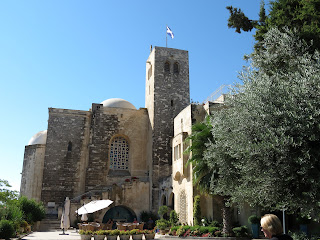A Piece of Scotland in Jerusalem
Today we worshiped at St. Andrew’s Scots
Memorial Church, the only Scottish church in Jerusalem as far as I know. St. Andrew’s is part of the Presbyterian
Church of Scotland and was completed in 1930 as a memorial to many Scottish
soldiers who lost their lives here in World War I.
The church sits high on a hill with a
commanding view all around Jerusalem and all the way to the Jordan Valley. Many landmarks are visible from the church such
as Mount Zion, the walls of the Old City, the city’s famous windmill, Dormition
Abbey, the valley of Hinnom (”Gehenna”), and more. You can see the Scottish flag atop the
towering spire of St. Andrew’s from all over one side of Jerusalem.
The church was very welcoming and
open. We were greeted at the door by a
kindly woman who showed us around and handed us a bulletin, a hymnal, and a
church Bible. I signed the guest book
and we went inside the library and the Guest Lounge before entering the
sanctuary. Outside in the courtyard
there were a few people sitting at tables having coffee.
As we entered the sanctuary I was
eager to see the beautiful imported marble on the chancel floor and Communion
table that I had heard about. Sure
enough, there was this green-veined white marble on the front of the Communion
table, the baptismal font, and the pulpit.
More of this marble could be seen on the floor of the chancel area. This marble is from the Scottish island of
Iona, a well-known center for Celtic spirituality, hospitality, and
ministry. The church’s brochure playfully
points out that part of the church being floored with marble from Iona means
that “the minister of St. Andrew’s stands on a piece of Scotland when
celebrating Communion in Jerusalem.” How
cool is that!
Also inlaid in the chancel floor is a bronze
plaque that reads: “In Remembrance of the Pious Wish of King Robert Bruce, That
His Heart Should Be Buried in Jerusalem.”
This refers to King Robert the Bruce of Scotland (1274-1329). Here is how the church’s literature describes
the reason for the plaque:
“The King’s dying wish was for his
heart to be buried in Jerusalem. His friend,
and companion-in-arms, Sir James Douglas, undertook the task. Carrying Bruce’s heart in a silver casket on
a chain around his neck, Douglas set off.
But he was killed in battle in Spain, while en route to Jerusalem. Bruce’s heart was returned to Scotland and
buried in Melrose Abbey. The plaque in
St. Andrew’s recalls and symbolizes the King’s wish.”
After the three of us sat down in the sanctuary
(we came early), the pastor came in and talked with us. He was a very friendly Scottish man who
wanted to know all about where we were from and how we were enjoying our stay in
Israel. When he found out I am a United
Methodist pastor, he told us about a young lady who is a General Board
missionary who is an ecumenical partner with the church. We exchanged emails and other information for
future correspondence.
There were only a few of us in
attendance this morning but the worship service was quite beautiful and
uplifting. The service was in English
and the liturgy for Holy Communion was enjoyed with a welcome familiarity. I especially was blessed by the prayers in
the service, which occurred in several places.
Since it was a fairly small group today, we all were invited to step up
on the chancel and stand in a semi-circle amid the Iona marble and next to the
pulpit chair with the sailing ship carved on the back. We passed the peace of Christ and served
Communion around the circle. It was
intimate, holy, and blessed. And we were
thankful.
After the service we were invited to
stay by the courtyard for coffee, cookies, and more warm hospitality and
conversation. We met a young man who
worshiped with us who was from the state of Georgia in the U.S. The young man just started work at the United
States Consulate in Jerusalem. He said
he is married and has two daughters, and if the situation stays calm enough he
hopes to bring them to Jerusalem soon.
The church also has a twenty-room guest house
(which might be a possibility for future groups) and a small Fair Trade gift
shop featuring hand-made embroidery, baskets, wood carvings, soaps, crafts, and
many other things from all over Israel.
I am a big fan of Fair Trade items: “Supporting economic self-help of
women, refugees, people with disabilities, family farmers and preserving the
artisan heritage.” We went inside and I
bought a nice Celtic cross that was hand-carved out of olive wood and Linda
surprised me with a beautiful hand-made pulpit stole embroidered with the
Jerusalem Cross!
Being of Scottish heritage (Buchanan,
you know), I was delighted to enjoy this little piece of Scotland here in the
land of Israel! I said a prayer for my
friend Fred who would be preaching for me back home in another eight
hours. We all had a wonderful time and
feel most blessed!










No comments:
Post a Comment